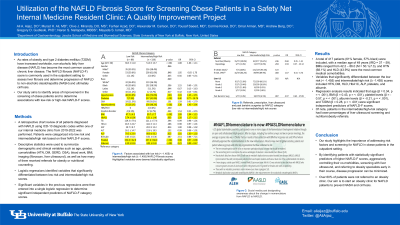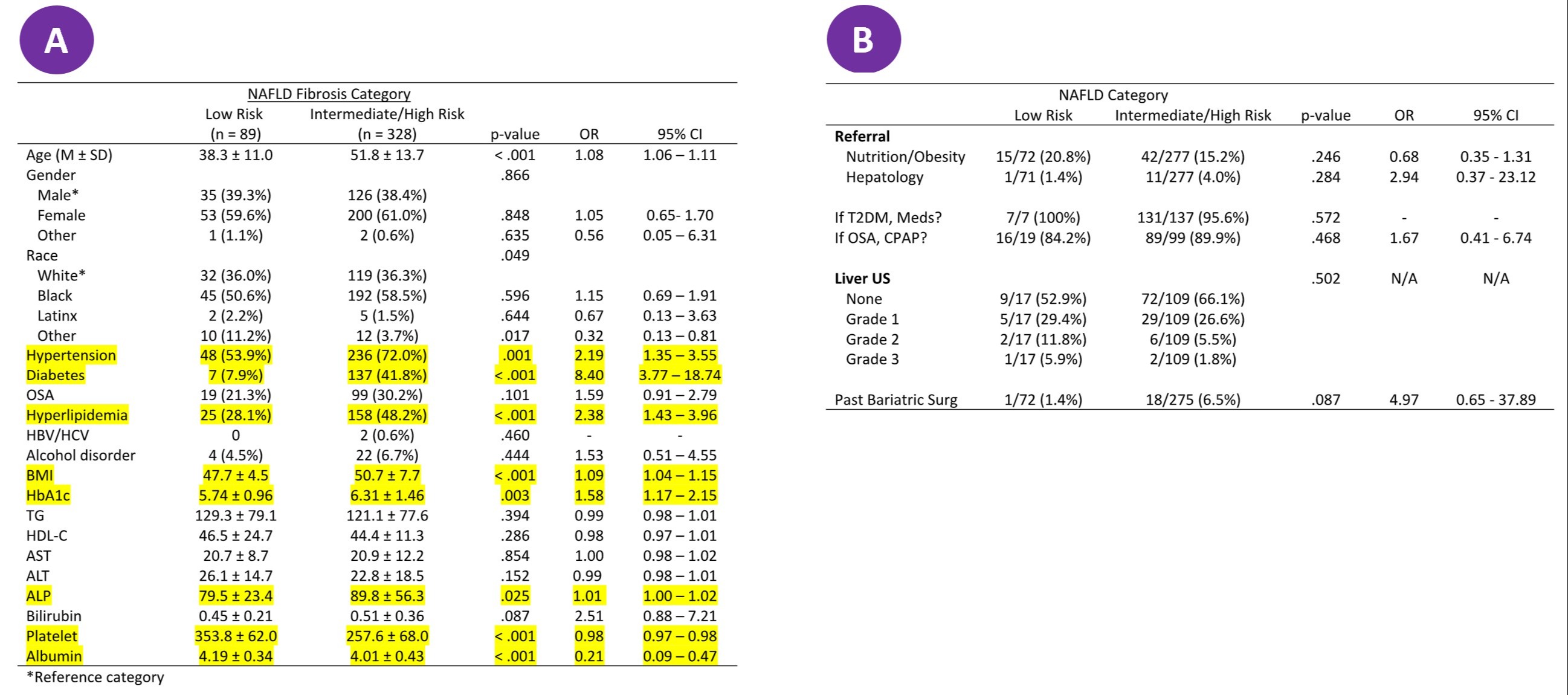Monday Poster Session
Category: Liver
P2383 - Utilization of the NAFLD Fibrosis Score for Screening Obese Patients in a Safety Net Internal Medicine Resident Clinic: A Quality Improvement Project
Monday, October 23, 2023
10:30 AM - 4:15 PM PT
Location: Exhibit Hall

Has Audio
- AA
Ali A. Aijaz, DO
University at Buffalo
Buffalo, NY
Presenting Author(s)
Ali A.. Aijaz, DO, Murad H. Ali, MD, Clive J. Miranda, DO, MS, Farhan Azad, DO, Alexander M. Carlson, DO, Yousaf Saeed, MD, Corrine Kickel, MD, Omar Arman, MD, Andrew Berg, DO, Gregory D. Gudleski, PhD, Naren S. Nallapeta, MBBS, Mayada Ismail, MD
University at Buffalo, Buffalo, NY
Introduction: As rates of obesity and type 2 diabetes mellitus (T2DM) have increased worldwide, non-alcoholic fatty liver disease (NAFLD) has become the most common cause of chronic liver disease. The NAFLD fibrosis (NAFLD-F) score is commonly used in the outpatient setting to assess liver fibrosis and determine progression of NAFLD to non-alcoholic steatohepatitis (NASH) and ultimately cirrhosis. Our study aims to identify areas of improvement in the screening of obese patients and to determine associations with low-risk or high-risk NAFLD-F scores.
Methods: This study comprised of obese patients from a safety net internal medicine resident clinic. Patients were categorized into low risk and intermediate/high risk based on their NAFLD-F scores. Descriptive statistics were used to summarize demographic and clinical variables. Logistic regressions identified variables that significantly differentiated between low risk and intermediate/high risk scores. Significant variables in the previous regressions were then entered into a single logistic regression to determine significant independent predictors of NAFLD-F category scores.
Results: A total of 417 patients (61% female, 57% black) were included, with a median age of 49 years (IRQ = 37 – 59). BMIs ranged from 42.2 – 86.0 (M = 50.1±7.3), and HTN (68.1%) and HLD (43.9%) were the most common medical comorbidities. Variables that significantly differentiated between the low risk (< -1.455) and intermediate/high risk (≥ -1.455) scores included HTN, DM, HLD, HbA1C, ALP, platelets, and albumin. Regression analysis results indicated that age (β = 0.34, p = < .001), BMI (β = 0.43, p = < .001), platelet levels (β = -0.57, p = < .001), albumin levels (β = -0.21, p = < .001), and T2DM (β = 0.28, p = < .001) were significant independent predictors of NAFLD-F scores. Of note, patients in the intermediate/high-risk category had lower percentages of liver ultrasound screening and nutrition/obesity referrals.
Discussion: Our study highlights the importance of addressing risk factors and screening for NAFLD in obese patients in the outpatient setting. By identifying patients with statistically significant predictors of higher NAFLD-F scores, aggressively controlling their co-morbidities, screening with liver ultrasound, and referring to obesity specialists early in their course, disease progression can be minimized. Over 60% of patients were not referred to an obesity clinic. Our aim is to start an obesity clinic for NAFLD patients to prevent NASH and cirrhosis.

Disclosures:
Ali A.. Aijaz, DO, Murad H. Ali, MD, Clive J. Miranda, DO, MS, Farhan Azad, DO, Alexander M. Carlson, DO, Yousaf Saeed, MD, Corrine Kickel, MD, Omar Arman, MD, Andrew Berg, DO, Gregory D. Gudleski, PhD, Naren S. Nallapeta, MBBS, Mayada Ismail, MD. P2383 - Utilization of the NAFLD Fibrosis Score for Screening Obese Patients in a Safety Net Internal Medicine Resident Clinic: A Quality Improvement Project, ACG 2023 Annual Scientific Meeting Abstracts. Vancouver, BC, Canada: American College of Gastroenterology.
University at Buffalo, Buffalo, NY
Introduction: As rates of obesity and type 2 diabetes mellitus (T2DM) have increased worldwide, non-alcoholic fatty liver disease (NAFLD) has become the most common cause of chronic liver disease. The NAFLD fibrosis (NAFLD-F) score is commonly used in the outpatient setting to assess liver fibrosis and determine progression of NAFLD to non-alcoholic steatohepatitis (NASH) and ultimately cirrhosis. Our study aims to identify areas of improvement in the screening of obese patients and to determine associations with low-risk or high-risk NAFLD-F scores.
Methods: This study comprised of obese patients from a safety net internal medicine resident clinic. Patients were categorized into low risk and intermediate/high risk based on their NAFLD-F scores. Descriptive statistics were used to summarize demographic and clinical variables. Logistic regressions identified variables that significantly differentiated between low risk and intermediate/high risk scores. Significant variables in the previous regressions were then entered into a single logistic regression to determine significant independent predictors of NAFLD-F category scores.
Results: A total of 417 patients (61% female, 57% black) were included, with a median age of 49 years (IRQ = 37 – 59). BMIs ranged from 42.2 – 86.0 (M = 50.1±7.3), and HTN (68.1%) and HLD (43.9%) were the most common medical comorbidities. Variables that significantly differentiated between the low risk (< -1.455) and intermediate/high risk (≥ -1.455) scores included HTN, DM, HLD, HbA1C, ALP, platelets, and albumin. Regression analysis results indicated that age (β = 0.34, p = < .001), BMI (β = 0.43, p = < .001), platelet levels (β = -0.57, p = < .001), albumin levels (β = -0.21, p = < .001), and T2DM (β = 0.28, p = < .001) were significant independent predictors of NAFLD-F scores. Of note, patients in the intermediate/high-risk category had lower percentages of liver ultrasound screening and nutrition/obesity referrals.
Discussion: Our study highlights the importance of addressing risk factors and screening for NAFLD in obese patients in the outpatient setting. By identifying patients with statistically significant predictors of higher NAFLD-F scores, aggressively controlling their co-morbidities, screening with liver ultrasound, and referring to obesity specialists early in their course, disease progression can be minimized. Over 60% of patients were not referred to an obesity clinic. Our aim is to start an obesity clinic for NAFLD patients to prevent NASH and cirrhosis.

Figure: Figure A: Factors associated with low risk (< -1.455) vs intermediate/high risk (≥ -1.455) NAFLD Fibrosis scores, with highlighted variables demonstrating statistical significance.
Figure B: Referrals, prescription, liver ultrasound and past bariatric surgeries by NAFLD low risk vs intermediate/high risk scores
Figure B: Referrals, prescription, liver ultrasound and past bariatric surgeries by NAFLD low risk vs intermediate/high risk scores
Disclosures:
Ali Aijaz indicated no relevant financial relationships.
Murad Ali indicated no relevant financial relationships.
Clive Miranda indicated no relevant financial relationships.
Farhan Azad indicated no relevant financial relationships.
Alexander Carlson indicated no relevant financial relationships.
Yousaf Saeed indicated no relevant financial relationships.
Corrine Kickel indicated no relevant financial relationships.
Omar Arman indicated no relevant financial relationships.
Andrew Berg indicated no relevant financial relationships.
Gregory Gudleski indicated no relevant financial relationships.
Naren Nallapeta indicated no relevant financial relationships.
Mayada Ismail indicated no relevant financial relationships.
Ali A.. Aijaz, DO, Murad H. Ali, MD, Clive J. Miranda, DO, MS, Farhan Azad, DO, Alexander M. Carlson, DO, Yousaf Saeed, MD, Corrine Kickel, MD, Omar Arman, MD, Andrew Berg, DO, Gregory D. Gudleski, PhD, Naren S. Nallapeta, MBBS, Mayada Ismail, MD. P2383 - Utilization of the NAFLD Fibrosis Score for Screening Obese Patients in a Safety Net Internal Medicine Resident Clinic: A Quality Improvement Project, ACG 2023 Annual Scientific Meeting Abstracts. Vancouver, BC, Canada: American College of Gastroenterology.
